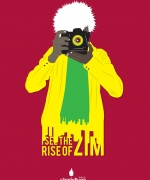Development of Graphic Design in Zimbabwe (1980 - 2000) - Interviews & Stats
Since there were no books on design in Zimbabwe all information had to come from interviews and stats were based on surveys I carried out on my own.
Statisics
From the information I was gathering for my project I compiled a couple of statistics about the industry and college. I must note that these statistics are estimated which I concluded from the research I did.
INDUSTRY SEX DISTRIBUTION – There are more men than woman in the design industry. About 90% of the designers in Zimbabwe are men. Reasons for this maybe that social stigma still want to see woman as secretaries. Parents in the case of black woman might play a role in discouraging but this is changing. Also some extremists might even argue that women are not creative as men!(?)
NUMBER OF DESIGNERS IN ADVERTISING AGENCIES – the maximum number of designers in an agency here in Zimbabwe is about three and a Creative Director and a copywriter.
AGE – The average of the designers in agencies varies but I have seen that most designers are in the 23 – 25 age group. RACE – During the 80’s there were more whites in the industry, but now it has evened out, but I see blacks going on to dominate the territory.
NUMBER OF ADVERTISING AGENCIES – During the 80’s there were very few agencies, mostly the multinational companies less than 10. Now there are more companies sprouting up and they can be in excess of 15 companies all over Zimbabwe 90% who are in Harare because that is where most company head quarters are located.
COLLEGE ENROLLMENT POLY – First year there are usually 25 students, to make it for the National Diploma, 5 chose Fine Art leaving 15 designers of which 13 pass the diploma course.
RACE RATIO – During the 80’s there were much more whites than blacks, then it was considered more of an elitist industry. But now there are more blacks e.g., Design for Print class 2001 there is one white girl, the only girl in a class of 15 students.
SEX RATIO – Compared with an even distribution during the 80’s, there is a drastic drop in the enrolment of girls. The college is trying to encourage girls to come by being less strict in their enrolment criteria but the numbers are still dropping. There is an average of about 6 girls at the start of he course but the number dwindles to about 2 or 3 due to failure or dropouts from pregnancies.
AGE RATIO – The 90’has seen a much younger generations of students with students coming straight after completing their O’Levels at about 17 years old. The general age is between 18 – 22 with the odd 28 year old. Compared to the 80’s where most part time students were much older and were already working. THE FUTURE The future of design in Zimbabwe??? I think the future of design in Zimbabwe depends on a few things. The economy for one is one of the major influences. But hopes are that if a new government is put n place then the economy will get back to its feet. I feel graphic design is Zimbabwe has a bright future. As more and more people are educated about the profession it offers more opportunity. On the other hand with deteriorating conditions at the Polytechnic and lack of support from the government, graphic design will always be foe few. In regards to technology, I think Zimbabwe is going quite okay with programmes constantly being updated to keep with the West and also with the availability of machines such as the Apple Macintosh G series. Design has moved towards the web. But here in Zimbabwe design for print is like denim jeans, it will never go out of fashion.
For design to develop further in this country one key word was consistent among most of the people I interviewed, “passion”, and two people who really drove the point home were Chaz Maviyane-Davies and Mike Danes. They stressed that to be able to create designs that will really affect the people you need to have a passion for design and focus on design. Not become a jack-of-all-trades and a master of none. Saki Mafundikwa has shown this passion in the work he is doing. It is this kind of attitude toward design that is going to help in the development of the industry in Zimbabwe.
Interviews
Below are a few extracts from Interviews I held with different designers.
JANE SHEPHARD (Interview)
Q. WHAT IS THE FUTURE OF GRAPHIC DESIGN IN ZIMBABWE?
A. There is no future for design in Zimbabwe with Mugabe at the helm. We will have to learn to be peasant farmers. If and when the economy turns around it will take years to build up what has been destroyed. Unless we have a vibrant manufacturing economy and a population with disposable income there wont be a design industry. Design in Zimbabwe would go the digital route with less being printed and more generated on the web. The brain drain will continue and without a relevant training programme we wont have the skills needed to keep abreast with the world. It is not looking very good.
Q. THERE IS AN EMPHASIS, ESPECIALLY FOR STUDENTS TO INDIGENISE THEIR DESIGN AND BE IDENTIFIED AS ZIMBABWEAN OR AFRICAN, WHAT ARE YOUR VIEWS?
-
Tendai Nyaundi (student): I feel anything original designed by a Zimbabwean regardless of the fact that it has all the chevron pattern or not. We don’t have to stay stigmatised with the same so-called ‘ethnic’ colours. I don’t want people to look at my work and say, “oh that’s Zimbabwean” without taking a second glance at it. That defeats the whole purpose of design which is to captivate the audience. I want them to stop and say, “Where is this from”.
- Chanetsa Mukahanana (student): By trying to reflect Zimbabwean in everything we do we are closing ourselves in a box. On the other hand if we can reflect Zimbabwe in all we do successfully that will create an identity. Instead of constantly referring to image banks from other countries, we can source our own images from around us which people can relate to easily as Zimbabwean, again that will create an identity for the country. One person who I feel is really captured the essence of Africa and design in his imagery is Chaz (Maviyane-Davies).
- Jane Shepherd (designer/lecturer): I think it is very hard to see your own future from a detached viewpoint when you live in it day to day. What may seem extraordinary to the outside world is invisible to you. This is a problem in the context that the rest of he world is interested in other cultures, yet we keep offering design that looks like it came from anywhere other than Africa. We have to observe very closely and recognise what is unique about where we live (easier said than done) and yet still stay in the parameters of ‘commercial design’. To me Zimbabwean languages and culture are rich in metaphors, sayings and symbolism which could be a huge source for ideas for designers. I feel that Zimbabweans in general lack pride in their own culture, Jacob Ngandu gave me a paper he wrote which backed up this lack of pride. The majority of Zimbabwean professionals are influenced by Eurocentric and American design trends and ideas, mostly via the media. Most of the popular movies here are American. People generally prefer things that have a direct or indirect link to Europe or America. However, Danes design capitalised on this obsession with America and created Sammy’s fast food outlet with an American. Immediately everyone wanted to be associated with the new ‘American’ fast food outlet. They would rather be associated with external first world beliefs, than the local ones, changing even the way they speak, dress and their actions. Design is aimed at the consumer and the consumer wants something that looks American therefore the designers are inclined to follow the requirements of the consumer hence design in Zimbabwe look likes its ‘from anywhere other than Zimbabwe’. It’s this inferiority complex that is hindering designers from coming up with identity/
JACOB NGANDU (Interview)
WHAT ARE SOME PROBLEMS FACED BY DESIGNERS?
A. One of the main problems is the commercial aspect of design from both the client side and the company doing the designs. Most companies who commission you to do design are strict about certain things hence disallowing to explore and experiment. More often than not they want their design work ‘yesterday’, therefore one has to work as fast as possible. With the design company they need to generate revenue and so they also have to turn over jobs quickly hence one has to work very fast.
ANTHONY MELLON (Interview)
Q. WHAT PROBLEMS DID YOU ENCOUNTER AT THE POLYTECHNIC DURING THE 80’s?
A. Off the top of my head, none. I cannot say we had any major problems. I enjoyed lecturing at the college. If problems did arise I attacked it as a challenge, which needed to be taken out. It was so enjoyable to the extent that every year the second years would go to Mana Pools for a week where we had lecturers, did drawing, painting and even went canoeing, it was one of my passions.
MIKE DANES (Talk)
Q. WHAT WOULD YOU CALL A NORMAL DAY?
A. My day starts off very early with a lot of administration work, which includes sorting out sales tax, staff salaries, depending on the time of month. I also work with other designers, brainstorming and helping each other. Then I go off to see clients. I receive at least 70-100 calls a day and meet with 10-15 clients each day. I also have to deal with suppliers, you need good relationship with them so they can do good work for you but you also have to keep breathing on their necks to get the job done in time for deadlines. I remember when I first started the studio I would work the whole night and sleep in the studio for an hour and be at the printers first thing in the morning. Due to administration the only time I ever get to design is during the night. Dane Design was born of hard work, long hours and a sheer passion for design.
CHAZ MAVIYANE-DAVIES (Talk)
Q. WHY DON’T YOU ENTER THE CDF (Creative Director Forum)?
A. I used to enter but certain people in the industry began to complain that “why does he enter if he keeps winning all the prizes?” I feel that if a person is good enough he must keep winning. It should encourage others to raise their standards. So I decided to get away from all of it and stopped entering and coming. I only came today to bid farewell to the industry as I am going to lecture at Minnesota University in January.
Continue Reading
Development of Graphic Design in Zimbabwe (1980 - 2000)
Design in Zimbabwe - Brief History Of Zimbabwe
Design Education in Zimbabwe 1980 - 2000
Development of Graphic Design in Zimbabwe (1980 - 2000) - Interviews & Stats
Development of Graphic Design in Zimbabwe (1980 - 2000) - Conclusion





